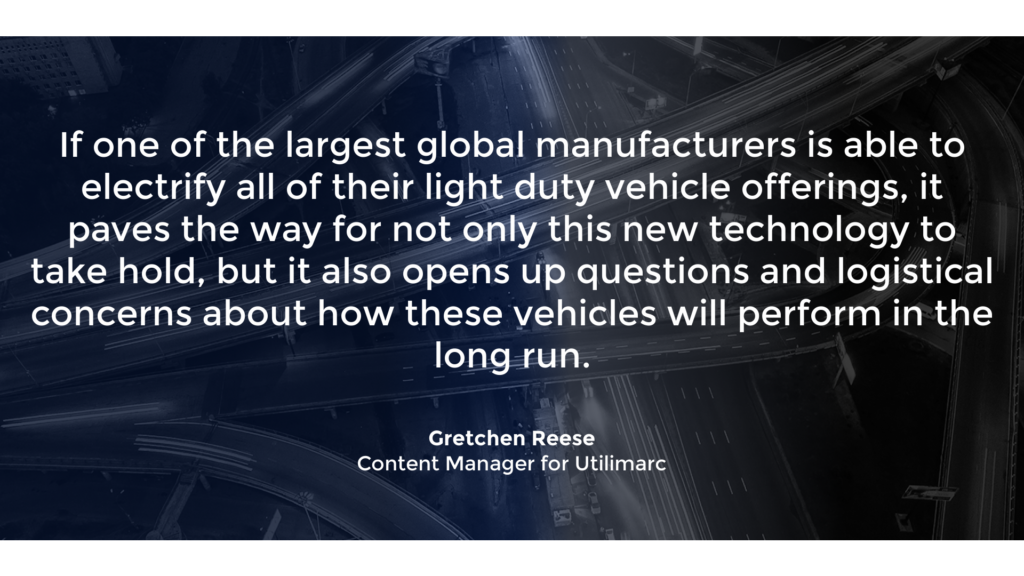
Amazon is Electrifying? Benchmarking Season? Here’s What is New in Fleet This Month
This week’s episode of the Fleet FYIs Podcast is seeing the beginning of a new monthly round-up series, The Fleet FYIs Monthly Hotlist.
Beginning today, I’m breaking down what’s making waves and revving engines this month in the fleet industry, as well as adding a bit of perspective from our analysts. The Monthly Hotlist will air during the last week of every month, making sure you’re caught up on top stories, new technology launches and new initiatives that’ll surely have people talking.
Here’s a quick summary of February’s highlights:
The fleet industry had a few exciting announcements roll out in the month of February. From GM announcing their new carbon neutrality pledge and new ultium battery-powered electric delivery vans, to a massive delivery fleet like Amazon making a massive push for sustainability – there’s a lot to chat about. But what’s really peaked my interest over the last couple weeks has been data pulls and preliminary trends – have a listen to find out more:

“Getting your data in as soon as possible allows you to review your internal information to ground and inform yourself on what’s happened statically to your fleet in the last year compared to the previous one.”
The Things You Need to Know In Fleet | February 2021 Monthly Hotlist | Utilimarc Fleet FYIs Podcast
“If one of the largest global manufacturers is able to electrify all of their light duty vehicle offerings, it paves the way for not only this new technology to take hold, but it also opens up questions and logistical concerns about how these vehicles will perform in the long run.”

February was an exciting month for fleet – with new technology, new carbon neutrality pledges and so much more. If you’d like to have a listen, it’s available to stream on all major platforms – but if reading is more your style, take a look at this episode’s transcript below:
Amazon is Electrifying? Benchmarking Season? Here’s What is New in Fleet This Month | Fleet FYIs: Season 2 Episode 5
Gretchen Reese (00:06):
Hey there. Welcome to Fleet FYIs, the weekly podcast by Utilimarc that reveals how you can make the most of your data for smarter fleet management. My name is Gretchen and every week you’ll hear from me and some of the industry’s finest in candid conversations that will shed some light on, not only two decades worth of data insights, but some of the industry’s hottest talking points and key metric analysis with the aim to help you better understand your fleet from every angle.
Gretchen Reese (00:33):
Before we begin, if this is the first time you’ve heard our show, thanks for stopping by. I’m so glad you decided to come along for the ride with us, but I’ve got a quick favor to ask you. Once you’ve finished today’s episode, if you could take a few minutes to leave us a review on your favorite podcasting platform, we would really appreciate it. Give us a rating, five stars I hope, or tell us what you liked or leave us a comment or a question about what you’ve heard in today’s episode. But if we haven’t yet covered a topic that you’re interested in hearing more about, let us know. We would be happy to go over it in detail in a later episode, if that sounds good to you, let’s get back to the show.
Gretchen Reese (01:17):
Hey there, and welcome back to another episode of the Fleet FYIs podcast. How’s it going? Is it just me or does it seem like winter is coming to a near end way too fast? It’s almost the end of February and whilst in Minnesota, we’ve even had snow way into May, if you can believe it or not, anyone who loves the snow and the cold will tell you that proper winter ends near to the end of March. It seems like it’s fast approaching, which for a skiing lover like me, I’m a little gutted about, I’ll admit it. I won’t lie. A bit of sunny weather does sound, it sounds nice, but I know that you all aren’t here for a little Gretchen catch up as tempting as that may be.
Gretchen Reese (02:00):
This week, I’m actually kicking off a new series called the Fleet FYIs Monthly Hotlist, which as you may have guessed, it is a monthly round up of all the top stories circulating within the fleet industry and a quick take from some of our analysts on the topic. You can look forward to a nice little round up at the end of every month to make sure that you’re up to date with all things fleet. So if that sounds good, let’s get started.
Gretchen Reese (02:27):
First up on the list. It is benchmarking season, for Utilimarc that is. Of course, I had to start our first monthly round up with a little bit of Utilimarc news. Every single year, our analytics team pulls together the data from each of our benchmarking application participants to provide a wholesome, big picture view of industry data for our clients. And what that means is we’re looking at a bunch of different metrics, like vehicle utilization, costs, operational efficiencies, so on and so forth. And typically this process of bringing in and analyzing our clients benchmarking data begins in early February, and we always encourage our clients to submit their data sooner versus later. You might ask why, because isn’t the benchmark the same whether you get your data in early or later, it’s all the same benchmark? Well, sure, but in a nutshell, getting your data in as soon as possible allows you the ability to review your internal information to ground and inform yourself on what’s happened statistically to your fleet in the last year compared to the previous one.
Gretchen Reese (03:27):
This information is going to be something that’s massive through COVID because, as one of our senior analysts, Jessica Adams, has spoken about, is that COVID has really thrown a lot of fleets for a loop. We’re going to see a lot of trends that perhaps vehicle utilization might be way up, fuel cost and consumption is going to be way up, but we really couldn’t do anything about it because the cleanliness and safety precautions and standards were so different skewed from many years in the past. So you’ll be able to see more quickly what’s changed, how the year’s events have impacted your fleet on a normal year or in a COVID year, such as this last one. And this could be in either a positive or a negative way, so you can make any needed data adjustments. And finally, you can check on your progress that your company made in terms of reaching your set goals and your initiatives, which is always really, really helpful, almost like a yearly check-in for your fleet.
Gretchen Reese (04:24):
By getting your data in sooner, you’ll also find yourself in a unique position to understand your fleet and where you stack up against peers as the rest of the benchmarking participants provide their fleet data. So with that being said, whether you’re a client of ours, or if you would like to be in order to access two decades worth of industry benchmarking data, we’d love for you to get in touch and schedule a demo with one of the members of our team. I’ll put the sign up information down in the description of this episode, as well as the show notes on our page, and we’ll look forward to hearing from you.
Gretchen Reese (05:00):
Next up on the list, revving engines and making waves in the industry is General Motors. You might have heard by now that GM has made a commitment to be fully carbon neutral by 2040, which is super exciting, and it should get all of you sustainability lovers totally pumped up. But what does that mean exactly? So for big picture view, it’s a massive, massive win for sustainability first off. To have such a massive brand and massive manufacturer with child brands like Ford, GMC, Chevrolet, Cadillac, Lincoln, and so many others to be making such a commitment to sustainable efforts that include electric vehicle production and new battery technology. The announcement made stated that the manufacturer was committed to being carbon neutral by 2040 in their global product lines and operations. Now, this goal was to be achieved or is to be achieved in part by aspiring to eliminate all tailpipe emissions from all of their light duty vehicle offerings, which otherwise could be called direct emissions by 2035, which is kind of exciting, I think.
Gretchen Reese (06:03):
I think that will have a massive impact on fleets, especially if they’re already looking towards electrification in the future. This pledge was backed by science-based targets that aimed toward a more sustainable future and a better environment overall, which is always great for future generations. And my question is, is how will this affect fleets going forward? Now, it’s no secret that this will affect utility fleets amongst others around the world. It’s not just going to happen in the US. If one of the largest global manufacturers is able to electrify all of their light duty vehicle offerings, it paves the way for not only this new technology to take hold, but it also opens up questions and logistical concerns about how these vehicles will perform in the long run.
Gretchen Reese (06:46):
For example, and this is probably one of my favorite things in one of our last episodes, which if you haven’t listened to the small mini series that we just recorded with Dave Meisel, the EVP of Operations for Quanta Services, he touches on this a little bit, but it was a really interesting point to bring up, especially with all of the events happening over the last couple of weeks in Texas. And that point was, if you operate a fleet that aids in storm relief, whether that’s winter storm relief, thunder storms, hurricane season, the lot, how would you send an electric vehicle for relief effort into an area lacking electricity? The power grid’s down. There’s no way to charge your vehicle and you run out of battery. What then? The answers can get a little bit muddy and rightfully so. And there’s certainly an area left to explore what data is available and other alternative charging methods. And I for one am certainly going to be excited to see what comes out of that.
Gretchen Reese (07:43):
I think what it will take in terms of increasing confidence amongst fleet managers worldwide, because like I said, it’s not just something that’s going to be affecting the US in itself. It’s going to be worldwide. In order to get them to adopt this growing technology trend, it’s a deep analysis of this new battery technology that relies on actual data, not anecdotal, actual data. It can’t just be a potentially this or the range could be that. Fleet managers are looking for concrete data, exact numbers that can back up the decision to make an investment into this new, exciting electrifying technology. I guess we’ll just have to wait and see how this one pans out, but I think it will be an interesting thing to look forward to.
Gretchen Reese (08:28):
Next up, we’re surrounding one of many people’s favorite companies during this last year known for their speedy, quick delivery and one-stop shop services. If you haven’t guessed by now, yes, it’s Amazon. Their new trial of their new fleet edition has a lot of people talking and rightfully so. They have just ordered some custom electric delivery vans from American automaker Rivian, which – this trial is beginning in Los Angeles, so very sunny California is going to see the technology first. And I think they’re trialing the other custom delivery vans in 15 other places across the country, if I’m not mistaken. But this one will be overall an interesting one to monitor, because I think it’ll give a better idea of how electric vehicles can work within a fleet setting, aside from the passenger model or the fully hybrid option like Ford was talking about earlier last year, around June time with one of their light duty pickup trucks.
Gretchen Reese (09:26):
It might be one that perhaps telecom fleets, or maybe even municipality fleets adopt, or perhaps even mail fleets in general, as we’ve been noticing some mail fleets that operate mostly in cities, UPS, FedEx being two, at least that I’ve seen driving down my neighborhood with electric vehicle on the side of the van. I think it’s exciting to see some of these big delivery fleets actually starting to look towards more sustainable options rather than just working on packaging and reducing fuel consumption. Big win in my book. But right now it appears that these vehicles, they have a charge range of about 150 miles per full battery. And Amazon facilities are prepping for this new electric delivery vehicle rollout by installing thousands of charge points at delivery hubs.
Gretchen Reese (10:11):
Now, along the same lines, General Motors also announced a new electric delivery vehicle. This one is part of their ultimum battery technology. The one that prompted the announcement to be fully carbon neutral by 2040 and completely tailpipe emission free for their light duty vehicle offerings by 2035. This vehicle offering has a range of about 250 miles per full battery, allowing customers to begin ordering this new EV in, I think, it’s the latter half of 2022. Perhaps this means we’ll start to see a new wave of delivery fleets electrifying their vehicles as more and more technology options from different manufacturers around the world are announced and released.
Gretchen Reese (10:51):
In my mind, it also poses the question, are they really ready to electrify? Companies and the fleets that belong to them are seemingly always on the lookout for ways to become more sustainable, and electric vehicles may just be the road to take. Newer technologies like these tend to have less real world data surrounding their potential success within the different industries when compared to their internal combustion counterparts. The largest pushback, I think, against fleet electrification comes from the lack of data, like I mentioned earlier. There’s a lack of concrete, actual data, rather than simply just anecdotal. And it comes from a lack of comparison to the current reliable internal combustion models that are already at work within the fleet industry. And those are the models that a lot of fleet operators, drivers, fleet directors, and the like, they all know and love.
Gretchen Reese (11:43):
So the key here is to be able to leverage your fleet data to identify which aspects of your fleet are best suited to electrification and which are not, because the thing to keep in mind here is it won’t happen overnight. And if anyone thinks so, it’s just not logical and it’s not realistic because an EV data analysis, if there’s no real world comparison to its internal combustion counterparts, it’s going to take time. It’s also not a one size fits all solution. Because if you look at one of the articles that we had published on our site a couple of weeks ago, Are EVs Suitable for All Regions? The answer is a little up in the air because whilst electric vehicles can operate in cold and warm climates and for different jobs, there’s no denying that, the charge ranges are significantly different between a vehicle that operates in California versus a vehicle that needs to tow heavy equipment and operate in colder temperatures such in Minnesota. So you never know.
Gretchen Reese (12:43):
But when we look to the future, we need to understand that the electric alternative could be a way to reduce the carbon footprint of utility fleets nationwide, as well as being a way to create a sustainable alternative for fuel-based fleets in general.
Gretchen Reese (13:02):
Last, but certainly not least, we are merging big tech and automotive here on Fleet FYIs with Ford and Google’s most recent strategic partnership announcement. The idea here is to accelerate Ford’s digital transformation with a more modernized operational strategy and power connected vehicle technology by pairing Google’s cloud-based service tech offering with Ford’s automotive technology. The six year partnership will see the leveraging of Google clouds artificial intelligence, machine learning, and data analytics technologies by Ford, with all vehicles, both made by Ford and Lincoln from 2023, to be powered by an Android operating system with built-in Google applications. Almost similar to a smartphone or a tablet that you might currently use at home. I think this will be an intriguing move to monitor personally, because it provides an innovative way to modernize vehicle offerings whilst providing personalized user experiences and data-driven opportunities for further vehicle optimization. Now, I don’t know about you, but I think the ability to be able to navigate your vehicle using voice only commands is going to prove incredibly useful.
Gretchen Reese (14:10):
For example, the people that have gone to Google Home or Amazon Alexa, and have never looked back. This will come in particularly handy when you’re running late to a destination and need a real-time traffic report as will be provided with all of their GPS services in the future. And it’s all yours. Just say the word. Now, it even works if you’re lost, which if you’re like me, it happens a lot more than you’d like to admit. So that’s definitely a benefit for Ford and Lincoln users from 2023 and onward. I think the thing that has many people intrigued though, myself included, is what this will mean for fleets. So my question is, will these vehicles be an offering snapped up by municipality fleets that can get away with sedans or similar type vehicles? Or will this be a commercial vehicle only? I guess we’ll just have to wait and find out, but I for one am very excited to know the answer to that one.
Gretchen Reese (15:10):
Well, that’s officially the end of our first monthly hotlist for all things happening in fleet. If you have a story to share or big news that you just can’t hold in, send me an email. I’ll put the contact information and the description of this episode, as well as in the show notes on our site. And who knows, you might just find yourself or your fleet in next month’s monthly hotlist. If today’s episode was one that got you thinking, let us know by using the hashtag Utilimarc Fleet FYIs on LinkedIn so we can see what you thought, because I’m always really excited to see what you guys think, how you guys are interacting with the episodes, and overall, if you’re liking the content, because that’s just nice for me to hear, to make sure we’re still putting out content that you all are really enjoying and engaging with. So that’s all from me today. We’ll be back in your headphones next Thursday, and I will see you there.
Gretchen Reese (16:04):
Hey, there, I think this is the time that I should cue the virtual high five, because if you’ve just finished listening to another episode of the Fleet FYIs podcast, if you’re already wanting more content, head over to utilimarc.com, which is Utilimarc with a C. U-T-I-L-I-M-A-R-C .com for the show notes and extra insights coming straight from our analysts to you. That’s all for me this week. So until next time, I’ll catch you later.
If you or someone you know is interested in being a guest on Fleet FYIs, please email our content manager with your request.

